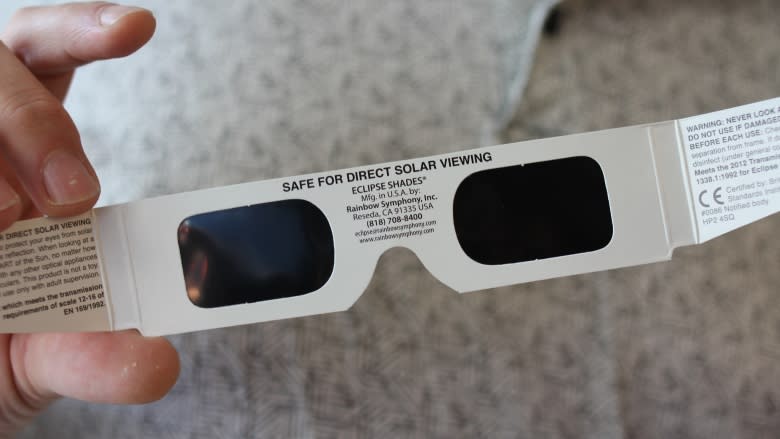How to view the partial solar eclipse in Ottawa
The skies are about to get darker on Monday afternoon as a partial solar eclipse passes over the National Capital Region.
But don't worry, even if animals begin acting strangely, it won't last for long.
The last time eastern Ontario experienced something close to this type of solar eclipse was an annular eclipse in the early 1990s. Those occur when the sun and moon line up, but the moon appears smaller and the sun therefore looks like a ring.
While eclipses are actually quite common, happening up to twice a year, the shadow track is so small that someone would have to travel to the exact part of the Earth where it's happening, said David Hanes, with the department of physics, engineering physics and astronomy at Queen's University.
He drove down to Nashville, Tenn., to get the best view.
60 per cent of sun covered in Ottawa
Ottawa will get about 60 per cent coverage, leaving between 35 and 40 per cent of the sun to shine through. It's a small enough area of coverage that one might not notice a large difference.
Total coverage will extend across a large swath of the U.S. — from Oregon to South Carolina — for the first time in nearly a century.
"It gets dark, kind of like twilight, but not twilight … When you're looking at the sun, the sun itself is gone. It's just a black dot, a black circle. But around the sun, you'd be able to see the corona, which is the atmosphere of the sun and then that would only last about two to three minutes," Jesse Rogerson, an astrophysicist and science advisor at the Canada Aviation and Space Museum, told CBC Radio's In Town and Out.
Then the moon continues its orbit and will stop blocking the sun.
The museum, along with the Royal Astronomical Society of Canada, is holding a viewing party on its grounds between noon and 4 p.m., with telescopes set up and eclipse glasses being handed out.
Animals could go into night mode
During a total eclipse, animals can act strangely, Rogerson said.
Since animals have a built-in rhythm tied to nature, even though it's the middle of the day, when the sun goes down they go into night mode, which means birds stop chirping and nocturnal animals, such as bats, emerge.
The eclipse begins at 1:17 p.m. ET when the moon begins to pass between the Earth and the sun — with the height of the coverage happening around 2:30 p.m. ET before the coverage begins decreasing again, ending around 4 p.m. ET.
Don't stare directly at sun
If you can't make it out to the museum, there are other ways to experience the eclipse yourself.
Special eclipse glasses can be purchased, but beware of fake glasses that have reportedly been sold.
A pinhole camera can also be another way to see the eclipse or head into the forest. Looking at the light projected through the canopy can be a great way to experience the eclipse, Hanes said.
The most important thing it is not to look directly at the sun, even if it appears dark enough, he said. The infrared light can irreparably damage the retina of the eye, like a sunburn that will never heal.
But taking a quick glance for a split second, like you might on a normal day, should be OK, he said.



